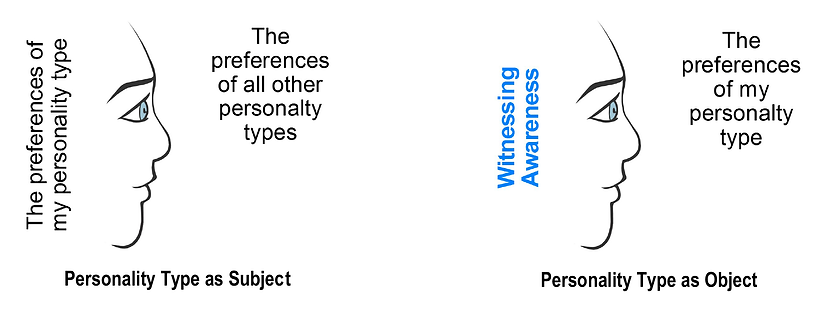SECTION 4
Personality Types
Unique Ways of Being and Growing
In this section we will consider personality types. Personality types represent preferences and strengths that tend to remain constant as we move through stages of development. Each personality type is based on a perceptual filter that determines what we pay attention to and how we direct our energy. Each represents a different way of being in the world and a different way of experiencing, perceiving, understanding, and responding to ourselves, others, and reality. Different personality types are likely the result of a combination of factors, including genetics, our early experiences in our family of origin, and our culture.
There are many different systems of personality typing. The two we will consider in this section are Jungian types, popularized in the Myers-Briggs Type Indicator (MBTI), and the Enneagram.
Our personality type affects all areas of our life. In the upper right quadrant it influences the way we move through stages of development and how we experience and understand God or Spirit. In the upper right quadrant our personality type affects our behavioral choices. In the lower left quadrant our personality type affects our communication and relationships, and who we feel (or don’t feel) close to. And in the lower right quadrant it affects our career choices and how we interact in the world at large.
Some Important Caveats
There are several important things to keep in mind about personality types. The first is that each personality type represents different potential strengths – which means that there are no “good” types or “bad” types, no “healthy” types or “sick” types – only different natural strengths and preferences. Secondly, personality typing is not intended to pigeonhole people. We all have some aspects of every type within us to differing degrees, and we can consciously cultivate strengths that come more naturally to a type other than our own.
Personality strengths taken to the extreme can become liabilities. For example, one strength of thinking types is that they bring objectivity and rationality to a situation. But taken to the extreme this strength can result in thinkers completely disregarding their own or others' feelings. On the other hand, one strength of feeling types is that they bring an awareness of people's feelings to any situation. But taken to the extreme, this strength can result in feelers over-personalizing and carrying a grudge for years.
It is important not to stereotype people by types, because each type encompasses a wide range of behavior, styles, values, and tastes. And personality type is only one aspect of who we are. In addition to our personality type, our biology, genetics, socioeconomic status, education, cultural values, stages of development, and life experiences all combine to make us uniquely who we are.
The Myers-Briggs Type Indicator (MBTI)
The Myers-Briggs Type Indicator, based on the work of Carl Jung, is one way of defining personality types. Each Myers-Briggs type is made up of four letters. Each letter identifies a preference that we have.
Preference #1: Extroversion (E) or Introversion (I)
This preference is about where we get our energy – from outside ourselves or from within ourselves – and the way we prefer to interact with the world.
Preference #2: Sensing (S) or INtuition (N)
This preference is about the way we prefer to gather information – in a literal, sequential way, or in a more figurative, intuitive way.
Preference #3: Thinking (T) or Feeling (F)
This preference is about the way we prefer to evaluate and make decisions about the information we gather – objectively and impersonally, or subjectively and interpersonally.
Preference #4: Perceiving (P) or Judging (J)
This preference is about which of the previous two preferences (information gathering, or evaluating and deciding) is the one we most prefer to use in our day-to-day lives in the outer world. In this context “judging” does not mean being judgmental or critical. Rather, it means a preference for having things decided – for making the best decision one can with the information at hand and revising it later if need be. And “perceiving” does not mean being especially perceptive. Rather, it means a preference for leaving things undecided as long as possible before a decision is made, in order to be open to new information that may come along.
Below is some basic information about each of these four preferences in the Myers-Briggs system.
Preference #1: Extroversion or Introversion
From “What Type Am I?” by Renee Baron
Preference #2: Sensing or Intuiting
From “What Type Am I?” by Renee Baron
Preference #3: Thinking or Feeling
From “What Type Am I?” by Renee Baron
Preference #4: Judging or Perceiving
From “What Type Am I?” by Renee Baron
When we combine these four preferences we get the 16 Myers-Briggs personality types.


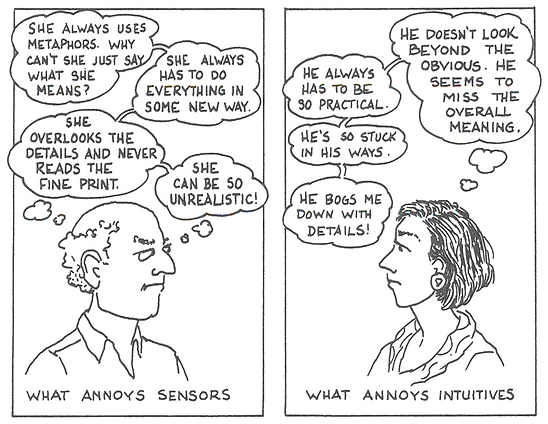

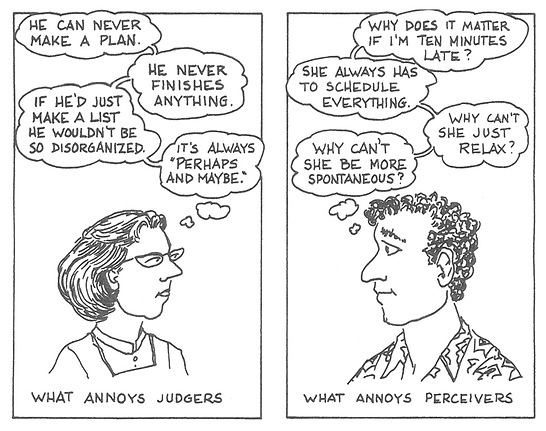

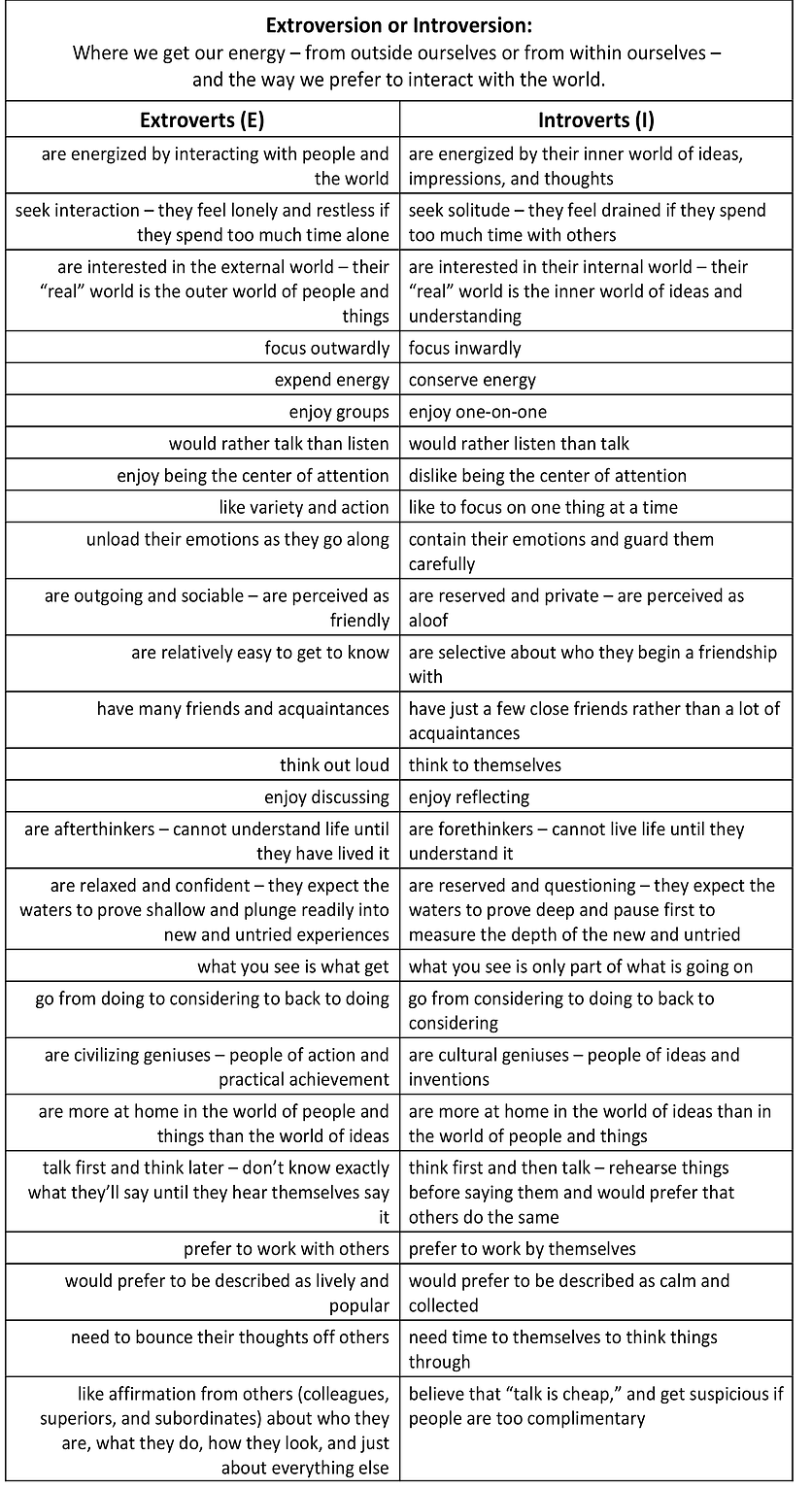
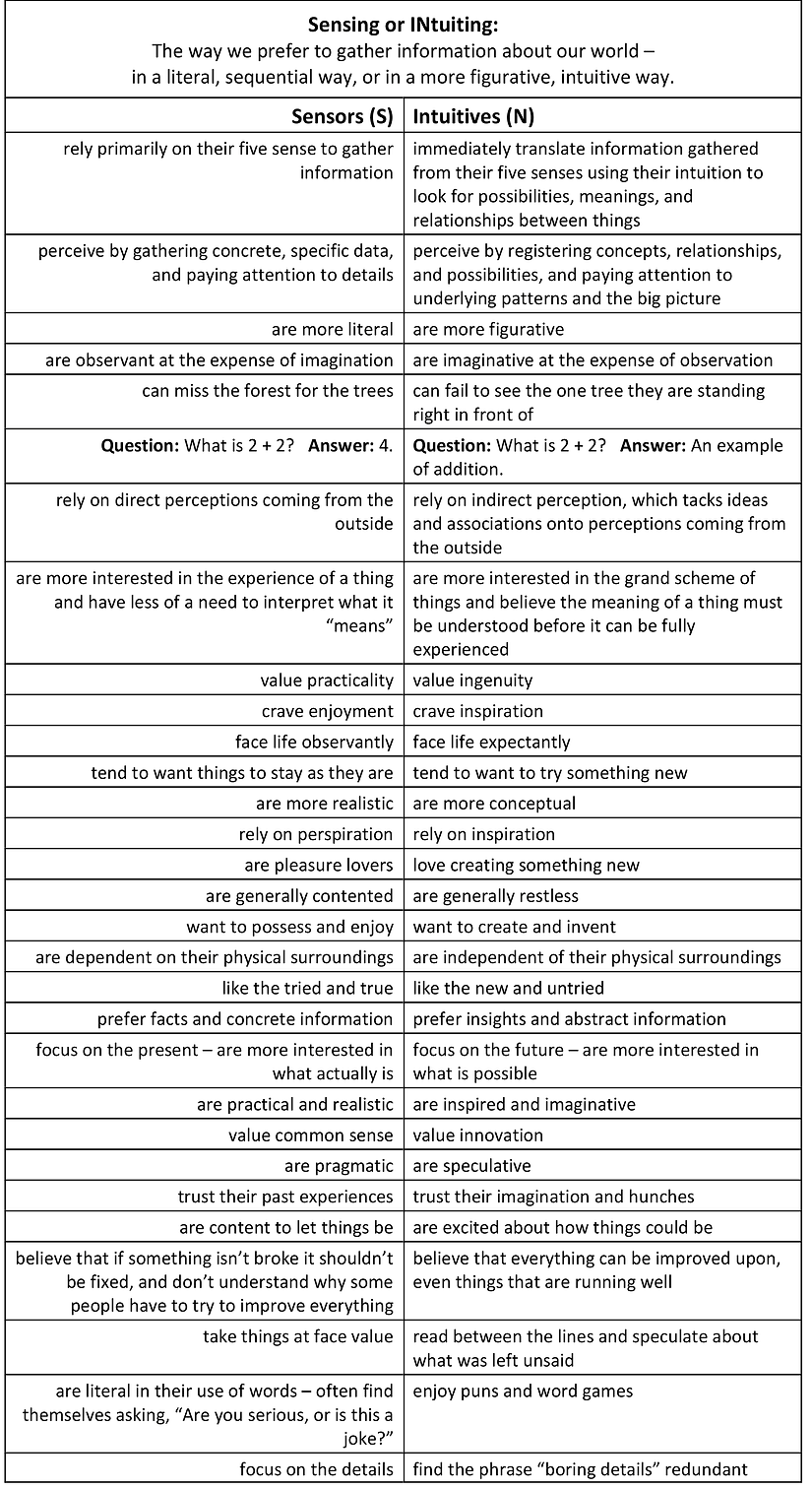
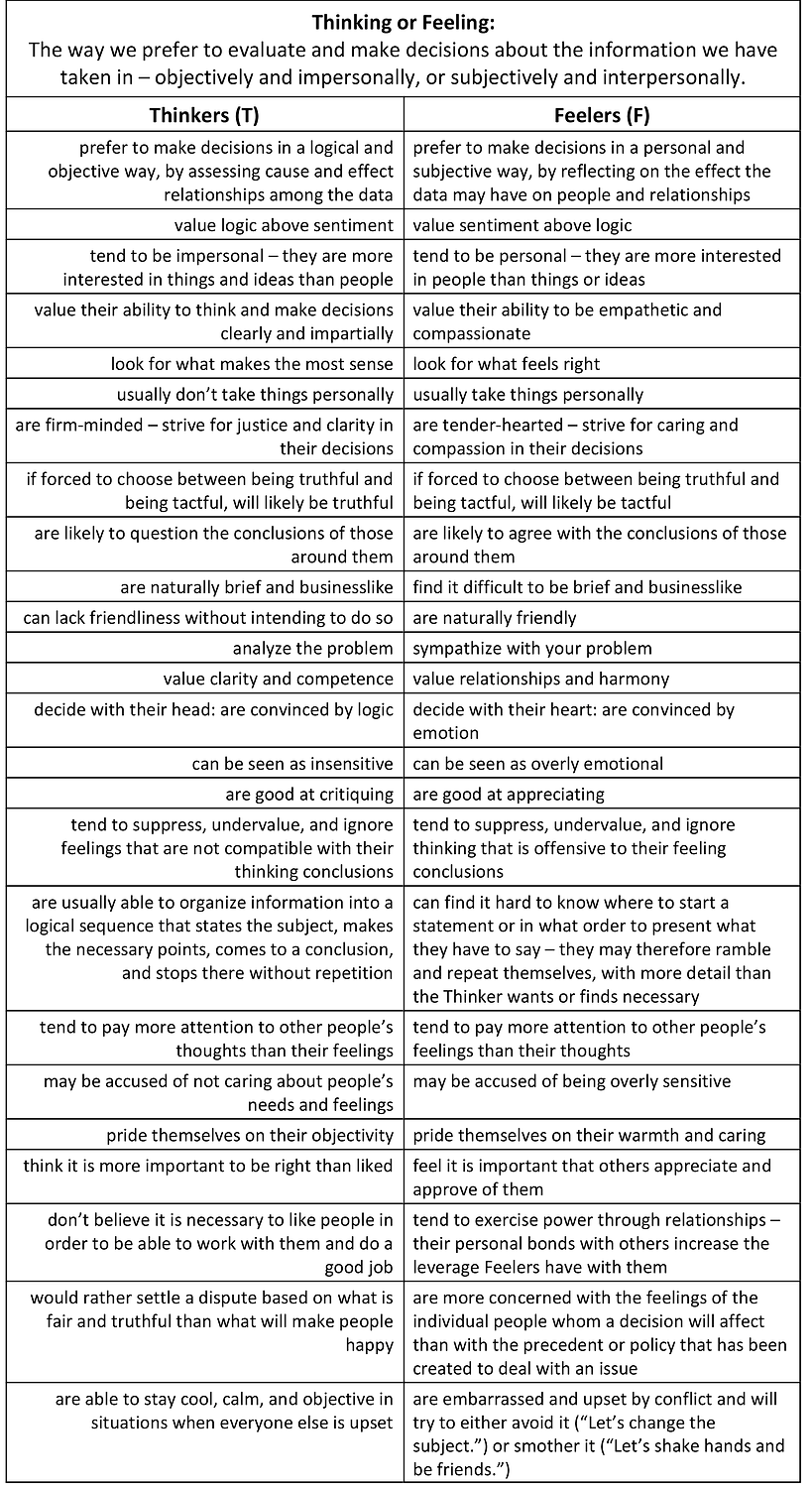

The Enneagram
The Enneagram is another system of personality typing. An enneagram is a geometric figure that maps out nine fundamental personality types and their complex interrelationships.
Eannea is Greek for the number nine, and gram means a figure. The enneagram is a nine-sided, nine-pointed figure used to represent each of the nine personality types.
This personality system describes nine distinct and fundamentally different patterns of thinking, feeling, and acting. Each of the nine patterns is based on a perceptual filter that determines what we pay attention to and how we direct our energy. Each represents a paradigm that is at the heart of how we think and feel about ourselves, and how we interact with others. Each represents a different way of being in the world and a different way of experiencing, perceiving, understanding, and responding to ourselves, others, and reality. Each type has it’s own strengths as well as challenges, and each is an equally valid way of being in the world. Each type can be healthy or unhealthy within their own type.
Each of us will probably be able to recognize one or more aspect of every type within ourselves, and we all have the capacity to experience the core value of each type. However, due to our unique combination of inborn temperament and early experiences, one of the nine will be our dominant type – our default setting and the motivational core that shows up again and again in our repetitive habits and patterns.
The nine core personality types in the enneagram are:
Type 1: The Good Person – The Reformer, The Perfectionist, The Paragon, The Improver
Healthy Ones are honest, hard-working, conscientious, sensible, responsible, ethical, serious, principled, purposeful, and self-disciplined. They strive to live up to their high ideals.
Type Two: The Loving Person – The Helper, The Giver, The Power Behind the Throne
Healthy Twos are generous, demonstrative, warm, concerned, nurturing, and sensitive to other people’s needs. They are interested in people.
Type Three: The Effective Person – The Achiever, The Motivator, The Producer, The Performer
Healthy Threes are energetic, adaptable, self-assured, competent, efficient, ambitious, and goal-oriented.
Type Four: The Original Person – The Individualist, The Romantic
Healthy Fours have sensitive feelings and are intuitive, warm, compassionate, romantic, imaginative, and self-expressive.
Type Five: The Wise Person – The Investigator, The Observer, The Sage, The Thinker
Healthy Fives are focused, curious, exploratory, observant, perceptive, insightful, complex, introverted, and independent.
Type Six: The Loyal Person – The Loyalist, The True Believer, The Troubleshooter
Healthy Sixes are reliable, hard-working, responsible, dutiful, trustworthy, courageous, and value loyalty to family, friends, groups, and causes.
Type Seven: The Joyful Person – The Adventurer, The Enthusiast, The Optimist
Healthy Sevens are active, energetic, spontaneous, lively, outgoing, adventurous, thrill-seeking, talkative, and optimistic.
Type Eight: The Powerful Person – The Leader, The Challenger, The Protector, The Top Dog
Healthy Eights are strong, assertive, resourceful, independent, self-reliant, self-confident, determined, direct, decisive, action-oriented, competitive, and pragmatic.
Type Nine: The Peaceful Person – The Peacemaker, The Mediator, The Negotiator
Healthy Nines are receptive, good-natured, patient, agreeable, easygoing, accommodating, reassuring, comforting, and supportive.
Enneagram Subtype: Wings
No two people who belong to the same enneagrem type are identical, although they share the same general preoccupations and concerns. The two points on either side of each enneagram type are called its wings. Wings influence each core personality type, and each person leans more to one wing type than to the other. The influence of the wings help make each personality unique.
Because each personality type has two possible wing types, the wings expand the nine enneagram types to 18 possible subtypes.
Enneagram Stress Points and Security Points
Our mental and emotional preoccupations change when we move from a secure life situation into a stressful one, or vice versa. Each enneagram type has another enneagram point they move toward (and behave more like) when they are under stress, and a different point they move toward when they are feeling secure. A person’s behavior in either security or stress can reflect either the strengths or the weakness of their stress or security type, depending on the particular individual, their level of development, and their circumstances. For example, a One under stress will tend to display either the positive or negative qualities of a Four. When feeling secure, a One will tend to display either the positive or negative qualities of a Seven.
Appendix D has more in-depth information about each of the enneagram types.
Self-Awareness & Communication
Learning about our own and others’ personality types has the potential to improve our communication with others, enhance our relationships, and help us make more effective choices. When we are unaware of our own and others’ personality types we may make inaccurate judgements about others. Because the needs of our type are so obvious to us, we tend to assume that they are obvious to everyone. They aren't, and this often leads to conflict and misunderstanding.
For example, extroverts tend to not understand introverts' need to reflect in peace and quiet, and introverts tend not to understand extroverts' need to verbalize everything. If I am an extroverted feeling type, I may interpret the behavior of an introverted thinking type as unfriendly or rejecting, when that is not what the other person intends. On the other hand, if I am an introverted thinking type, I may interpret the behavior of an extroverted feeling type as smothering or clingy, when that is not what is motivating the other person.
Without an awareness of our own and others’ personality types, we are at risk of judging others’ behavior based on what it would mean for a person of our type to act in a particular way, which may be very different from what that behavior might mean to a person of another type. Understanding personality types helps us avoid misreading each other's motives and intentions, and then judging others based on those misperceptions.
The more we understand about different personality types, the more we will be in a position to negotiate and work successfully with others who are different from us. When we can re-interpret conflicts through the lens of the personality types of the individuals involved, we can are better able to see the merit on both sides.
Application to Integral Spirituality: Different Paths up the Mountain
The integral model can be applied to any discipline -- education, politics, law, etc. Wilber has applied them to spirituality and created a model he calls integral spirituality. Below are some of the ways that an understanding of personality types can inform an integral approach to spirituality.
By incorporating an understanding of personality types and helping us understand the influence of our personality type – including both its strengths and challenges – an integral spirituality could support our healthy ego development and help us improve our relationships with one another. It could also help us become aware of how our personality type might affect our spiritual understanding and practice. For example, our personality type can influence whether we are drawn to experiences of God or Spirit in 1st, 2nd, or 3rd person, which spiritual practices speak to us, and which aspects of spirituality in terms of quadrants (inner or outer, individual or collective) we feel most drawn to.
Becoming consciously aware of the preferences of our personality type can also help us make subject into object. Understanding our type allows us to move our personality preferences from subject – from the invisible lens we are embedded in and controlled by, or something that "has us" – to object – to something that "we have," something that we are consciously aware of and can make intentional choices about. This has implications for both our ego development and our spiritual awakening.
Two books that explore how understanding, and then transcending, the preferences of our personality type can lead to spiritual awkakening are:
-
The Enneagram of Liberation: from Fixation to Freedom, by Eli Jaxon-Bear
-
The Wisdom of the Enneagram: the Complete Guide to Psychological and Spiritual Growth for the Nine Personality Types, by Don Riso and Russ Hudson.

